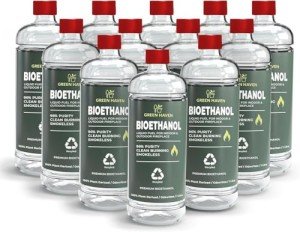Bio ethanol fuels are a fantastic choice for anyone looking to enjoy a cozy fire without the hassle. These clean-burning fuels create beautiful flames and don’t produce harmful smoke or ash, making them perfect for indoor use. Plus, they're super easy to use—just pour, light, and relax.
Bio Ethanol Fuels
Experience clean and efficient warmth with our premium selection of bio ethanol fuels for your fireplaces and stoves
Product List


Premium 6L Bioethanol Fuel
Biofiresireland Ltd
Product Review Score
4.16 out of 5 stars
36 reviews$34.64

Biola 24L Smoke-Free Ethanol
Biofiresireland Ltd
Product Review Score
4.52 out of 5 stars
135 reviews$93.30

Smokeless Bioethanol Fuel
Biola
Product Review Score
4.37 out of 5 stars
161 reviews$186.61 $177.29








As society grapples with the pressing challenges of climate change and fossil fuel dependency, bioethanol fuels have emerged as a viable alternative. Derived from the fermentation of biomass, bioethanol is increasingly utilized for transportation and energy generation. This blog post delves into what bioethanol fuels are, how they are produced, their environmental impact, and their potential as a sustainable energy source, while addressing frequently asked questions.
What is Bioethanol?
Bioethanol is a renewable, alcohol-based fuel produced primarily from plant materials such as corn, sugarcane, and other crops rich in starch or sugar. It can be blended with gasoline in various proportions to fuel vehicles, and it can also be used in some industrial processes. Key advantages of bioethanol include its ability to reduce greenhouse gas emissions and its potential to create energy security by diversifying energy sources.
Production of Bioethanol
The production of bioethanol involves several steps, which can vary depending on the feedstock used. The two primary methods of bioethanol production are fermentation and chemical processes.
Key Steps in Bioethanol Production:
- Feedstock Selection: Choosing the right biomass feedstock (e.g., corn, sugarcane, cassava).
- Pretreatment: Breaking down the complex structure of the biomass to release fermentable sugars.
- Fermentation: Microorganisms (typically yeast) convert sugars into ethanol and carbon dioxide.
- Distillation: The fermentation mixture is heated to separate ethanol from water and other components.
- Dehydration: Remaining water is removed, resulting in higher purity ethanol.
- Denaturing: Ethanol may be denatured to make it unsuitable for human consumption, particularly for fuel use.
The following table summarizes common feedstocks and their estimated ethanol yields:
| Feedstock | Approximate Ethanol Yield (Liters per Ton) | Potential Land Use (Hectares/Ton of Ethanol) |
|---|---|---|
| Corn | 400 - 450 | 0.4 - 0.5 |
| Sugarcane | 600 - 700 | 0.3 - 0.4 |
| Wheat | 300 - 400 | 0.5 - 0.6 |
| Cassava | 200 - 250 | 0.5 - 0.7 |
| Sorghum | 400 - 500 | 0.6 - 0.7 |
Environmental Impact
Benefits of Bioethanol
- Reduced Greenhouse Gas Emissions: Bioethanol can lead to lower emissions of CO2 and other pollutants when compared to fossil fuels.
- Sustainability: With proper land management and agricultural practices, bioethanol production can be renewable and sustainable.
- Energy Independence: Bioethanol can lessen dependency on imported fossil fuels, enhancing energy security.
- Economic Growth: The bioethanol industry can create jobs, especially in rural areas where feedstocks are grown.
Concerns About Bioethanol
- Land Use: Converting food crops into fuel can lead to food shortages and increased food prices.
- Water Usage: Some bioethanol production processes require significant water resources, raising concerns in arid regions.
- Biodiversity: Large-scale bioethanol production may threaten local ecosystems and biodiversity due to monoculture farming practices.
Current Applications and Potential
Bioethanol is primarily used in transportation, particularly in flexible-fuel vehicles (FFVs), which can operate on varying blends of ethanol and gasoline. According to the U.S. Renewable Fuels Association, bioethanol accounted for 10% of the gasoline supply in the United States in 2020.
Future Trends in Bioethanol
- Enhancements in Production Efficiency: Emerging technology like cellulosic ethanol production harnesses non-food biomass, which may alleviate food versus fuel concerns.
- Integration with Other Renewable Sources: Bioethanol can be combined with other renewable fuels such as biodiesel for versatile energy solutions.
- Advancements in Genetic Engineering: The development of genetically modified crops to increase sugar yields could produce more ethanol with less environmental impact.
Bioethanol fuels represent a promising avenue in the transition towards sustainable energy sources. While there are challenges to overcome, the benefits provided by bioethanol make it an attractive alternative to fossil fuels. Ongoing research, technological developments, and policy changes can help maximize its potential while addressing environmental concerns.
FAQs
What are the main sources of bioethanol?
The primary sources of bioethanol include corn, sugarcane, wheat, and various other starch and sugar-rich materials.
Can bioethanol be used in regular gasoline vehicles?
Yes, bioethanol can be blended with gasoline in varying proportions, with E10 (10% ethanol) and E85 (85% ethanol) being common blends for use in vehicles.
Is bioethanol production environmentally friendly?
While bioethanol has lower greenhouse gas emissions compared to fossil fuels, its environmental impact can vary based on agricultural practices, land use, and water consumption.
What is the difference between bioethanol and other biofuels?
Bioethanol is an alcohol-based fuel, whereas other biofuels, like biodiesel, are derived from fats and oils. They have different chemical properties, production methods, and compatibility with existing fuel infrastructure.
Are there any alternatives to bioethanol?
Yes, alternatives include biodiesel, renewable diesel, solar energy, wind energy, and electric vehicles, each contributing uniquely to reducing greenhouse gas emissions and fostering energy independence.
In summary, bioethanol fuels offer a promising path toward a greener future. Through sustainable practices and technological advancements, they can help mitigate climate change while supporting economic growth.